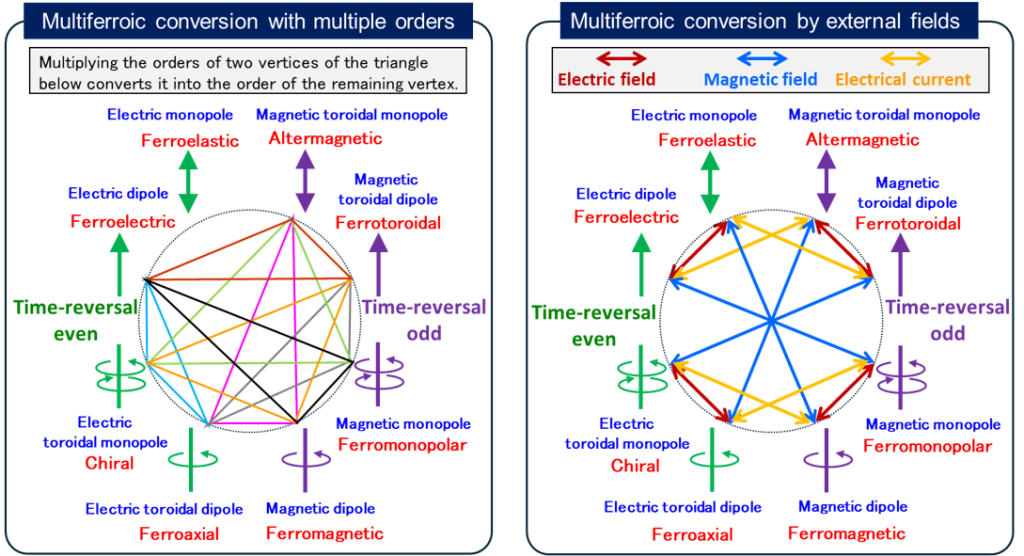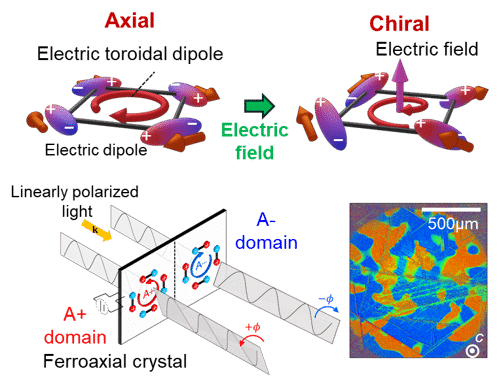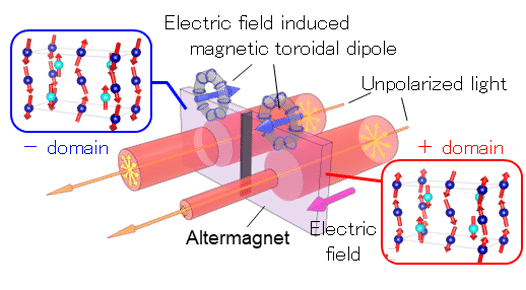Exploration of Novel Materials’ Properties Based on Multiferroic Conversion
We explore novel materials’ properties resulting from the conversion of ferroic states by combining multiple ferroic states classified according to the breaking of various symmetries, such as time reversal, space inversion, rotation, and mirror symmetries. We term such conversion “multiferroic conversion“. Through approaches such as materials design and development based on the multiferroic conversion and experimental demonstrations of the conversion by external perturbations, we establish the concept of multiferroic conversion which ties seemingly unrelated ordered states, and manifests new materials’ properties by freely converting the ferroic state.

Background
Previous Research about ferroic orders
Materials that exhibit multiple ferroic orders are called multiferroics. Among them, those showing the coexistence and/or combination of magnetic order breaking time-reversal symmetry and ferroelectric order breaking space-reversal symmetry have been extensively studied over the past twenty years. Recently, studies on ferroic materials expand toward new classes of ferroic states with various symmetry breakings such as “ferrotoroidal order” breaking both time reversal and space inversion and “ferroaxial order” breaking some mirror symmetry.
Focusing on Multiferroic Conversion
Recently, our group demonstrated that the application of an electric field to ferroaxial materials manifests optical phenomena specific to chiral materials, such as optical rotation and magnetic chiral dichroism (Link). This phenomenon can be viewed as a symmetry conversion from the ferroaxial state to the chiral state by an applied electric field. This research project extends this idea to a broader range of ferroic states, which we term “multiferroic conversion”. We explore experimental demonstrations of new materials’ properties based on the multiferroic conversion.

Movies about our previous studies are here.
Purpose of our Research
We establish the concept of multiferroic conversion that connects different ordered states by designing and synthesizing materials and developing observation methods for a wide variety of materials, including magnetic materials, metals, semiconductors, and dielectrics. To achieve novel materials’ properties and functionalities resulting from this conversion, we will proceed with the following approaches.
(1) Multiferroic conversion with multiple orders
By combining multiple ferroic orders, we demonstrate multiferroic conversion to a different ferroic order for a variety of orders . An example of this type conversion is shown below.

(2) Multiferroic conversion by external fields
We demonstrate the multiferroic conversion induced by external perturbations such as electric fields, magnetic fields, and electrical currents. An example of this type conversion is shown below.

(3) Improvement of multiferroic properties
Improvement of known multiferroic properties (e.g., enhancement of the effect, room-temperature operation, etc.) will be pursued through approaches such as consideration of electronic transitions and materials development.